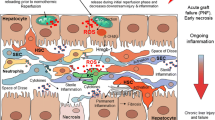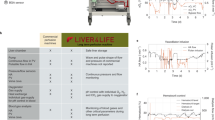Summary
Liver resections are usually performed under occlusion of the hepatoduodenal ligament (Pringle manoevre) in order to limit operative blood loss. The maximal ischemic tolerance, although individually different, is generally accepted to be 60 min. Resections of centrally located tumors require precise preparation, sometimes combined with vascular reconstructions. In such cases a prolonged ischemic time is inevitable. A save prolongation of the ischemic tolerance could be useful for extensive liver resections. In an experimental study in pigs ischemic tolerance of the liver was studied under hypothermic protection with the HTK solution of Bretschneider during 2 and 3 h. Deterioration of liver function was compared with a warm ischemia during 2 h. Results showed significantly less serum transaminase activities and better hepatic blood flow (ICG test) after an ischemia under protection with the HTK solution compared to a warm ischemia during 2 h. A prolonged ischemia during 3 h under protection with the HTK solution was well tolerated. First clinical applications of hypothermic hepatic protection during resection were successful.
Zusammenfassung
Leberresektionen werden zur Vermeidung größerer Blutverluste unter Okklusion des Ligamentum hepatoduodenale (Pringle manoevre) durchgeführt. Die maximale Ischämietoleranz, wenngleich individuell verschieden, wird in der Regel mit 60 min angegeben. Die Resektion von ungünstig gelegenen Tumoren erfordert eine präzise Präparation gegebenenfalls mit Gefäßrekonstruktionen, wodurch die Grenzbereiche der Ischämietoleranz häufiger erreicht werden. Eine sichere Ischämietoleranz gewinnt mit dem Resektionsausmaß zunehmende Bedeutung. Im Rahmen einer tierexperimentellen Studie wurde die Ischämietoleranz der Leber unter in-situ Protektion mit der HTK-Lösung nach Bretschneider während 2 bzw. 3 h untersucht und mit den funktionellen Auswirkungen einer 2-h warmen Ischämie verglichen. Die Ergebnisse ergaben nach einer Protektion mit der HTK-Lösung signifikant niedrigere Transaminaseaktivitäten und bessere Durchblutungsparameter (ICG-Test) gegenüber einer warmen Ischämie bei gleicher Ischämiezeit (2 h). Die Ischämietoleranz konnte durch die Protektion auf 3 h ausgeweitet werden. Erste klinische Anwendungen einer Resektion der Leber unter hypothermer Protektion mit der HTK-Lösung waren erfolgreich.
Similar content being viewed by others
Literatur
Belzer FO, Southard JH (1988) Principles of solid organ preservation by cold storage. Transplantation 45:673–676
Bernhard WF, Mc Murray JD, Curtis GW (1955) Feasability of partial hepatic resections under hypothermia. N Engl J Med 243:159–164
Bismuth H, Houssin D, Mazmanian G (1983) Postoperative liver insufficiency: prevention and management. World J Surg 7: 505–510
Blech M, Kallerhoff M, Kehrer G et al. (1988) Klinische Anwendung der kardioplegischen Lösung HTK nach Bretschneider zur in situ Protektion der Niere. Urologe [A] 27:44–48
Eßer G (1983) Leberresektionen im Grenzbereich der Toleranz. In: Häring R (Hrsg) Edition Medizin, Weinheim Deerfield Beach Basel, S 17–35
Fortner JG, Shin MH, Howland WS (1971) A new concept in hepatic lobectomy: experimental study and clinical application. Arch Surg 102:312–315
Fortner JG, Shin MH, Kinne DW, Castro EB, Watson RC, Howland WS, Beattie EJ (1974) Major hepatic resections using vascular isolation and hyperthermic perfusion. Ann Surg 180:644–652
Fortner JG, Kim DK, Maclean BJ et al. (1978) Major hepatic resections for neoplasia: personal experience in 108 patients. Ann Surg 188:363–371
Freeman BA, Crapo JD (1982) Biology of disease-free radicals and tissue injury. Lab Invest 47:412–426
Gelman SI (1976) Disturbances in hepatic blood flow during anaesthesia and surgery. Arch Surg 111:881–883
Goodall GW, Hyndman GW, Gurd FN (1957) Studies on hypothermia in abdominal surgery. Arch Surg 119:264–268
Gottlieb ME, Stratton HH, Newell JC (1984) Indocaninegreen: its use as an early indicator of hepatic dysfunction following injury in man. Arch Surg 119:264–268
Gubernatis G, Pichlmayr R, Lamesch P et al (1990) HTK-solution (Bretschneider) for human liver transplantation — first clinical experiences. Langenbecks Arch Chir 375:66–70
Harris KA, Wallace C, Wall WJ (1982) Tolerance of the liver to ischemia in the pig. J Surg Res 33:524–530
Isemer FE, Bruggemann A, Schunk O, Bretschneider HJ (1987) Kidney organ procurement with the HTK solution of Bretschneider. Transplant Proc 20:885–889
Iwatsuki S, Starzi TE (1988) Personal experience with 411 hepatic resections. Ann Surg 208:421–434
Kallerhoff M, Kehrer G, Siekmann W, Blech M, Gebhard M, Helmchen U, Bretschneider HJ (1985) Experimentelle Anwendung der kardioplegischen Lösung HTK nach Bretschneider für eine in-situ Protektion von Nieren. In: Harzmann R (Hrsg) Experimentelle Urologie. Springer, Berlin Heidelberg New York, S 180–188
Kehrer G, Aminali A, Gersing G et al. (1990) Glycogen effects on energy state and passive electric properties of liver during protection. Z Gastroenterol 3:147–156
Kresh JY, Nestala C, Bianchi PC, Goldman SM, Brockman SK (1987) The relative buffering power of cardioplegic solutions. J Thorac Cardiovasc Surg 93:309–311
Lamesch P, Ringe B, Neuhaus P, Burdelski M, Oellerich M, Pichlmayr R (1988) Qualitative assessment of liver function after hypovolemic, hypoxemic and ischemic shock in a transplantation model. Transplant Proc 20:994–995
Lamesch P, Ringe B, Blumhardt G, Pichlmayr R (1989) Effect of xanthine oxydase inhibition on warm ischemic lesions of the liver. Transplant Proc 21:1285–1286
Lamesch P, Raygrotzki S, Kehrer G, Gubernatis G, Pichlmayr R (1990) Preservation of the liver with the HTK solution. Transplant Proc 22:518–519
Matsumata T, Kanematsu T, Yoshida Y, Furuta T, Yanaga K, Sugimachi K (1987) The indocyanine-green test enables prediction of postoperative complications after liver resections. World J Surg 11:678–681
Nordlinger B, Douvin D, Javaudin L, Bloch P, Aranda A, Boschat M, Huguet C (1980) An experimental study of survival after two hours of normothermic hepatic ischemia. Surg Gynecol Obstet 150:859–864
Pachter HL, Spencer FL (1983) Experience with finger fracture technique to achieve intrahepatic hemostasis in 75 patients with severe injuries of the liver. Ann Surg 197:771–777
Pichlmayr R, Bretschneider HJ, Kirchner E et al (1988) Ex-situ Operationen an der Leber-eine neue Möglichkeit in der Leberchirurgie. Langenbecks Arch Chir 373:122–126
Pichlmayr R, Grosse H, Hauss J, Gubernatis G, Lamesch P, Bretschneider HJ (1990) Technique and preliminary results of extracorporeal liver surgery (bench procedure) and of surgery on the in-situ perfused liver. Br J Surg 77:21–26
Pringle HJ (1908) Notes on arrest of hepatic hemorrhage due to trauma. Ann Surg 48:531–549
Reimann B, Lierse W, Schreiber HW (1983) Anastomosen zwischen Segmentarterien der Leber und phrenico-hepatische arterio-arterielle Anastomosen. Langenbecks Arch Chir 359:81–92
Teranaka M, Schenk WG jr (1977) Hepatic blood flow measurement: a comparison of the indocyanine-green and electromagnetic techniques in normal and abnormal flow rates. Ann Surg 185:58–63
Sacks T, Moldow CF, Craddock PR, Bowers TK, Jakobs HS (1978) Oxygen radicals mediate immune vascular damage. J Clin Invest 63:1163
Stone HH, Long WD, Smith RB (1969) Physiologic considerations in major hepatic resections. Am J Surg 117:78–84
Weiss SJ, Lo Buglio AF (1982) Phagocyte generated oxygen metabolites and cellular injury. Lab Invest 47:5
Yamamoto S, Nitta N, Wada Y, Kamiyama Y, Yamaoka Y, Ozawa K (1988) Hepatic warm ischemia in pigs using a centripetal force pump. Surg Res Commun 3:5–14
Author information
Authors and Affiliations
Additional information
Mit Unterstützung der Demschen Forschungsgemeinschaft
Rights and permissions
About this article
Cite this article
Lamesch, P., Raygrotzki, S., Kehrer, G. et al. In-situ-Protektion der Leber mit der HTK-Lösung nach Bretschneider. Langenbecks Arch Chiv 376, 85–92 (1991). https://doi.org/10.1007/BF01263465
Received:
Issue Date:
DOI: https://doi.org/10.1007/BF01263465




